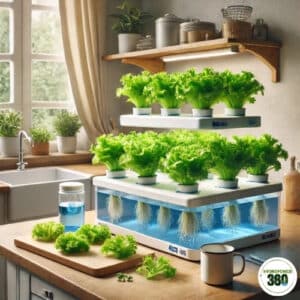Growing Hydroponic Lettuce at Home
Table Of Content
If you’re looking for a method to enjoy fresh, homegrown produce no matter the season, hydroponic lettuce might be the perfect endeavor for you. This technique eliminates the need for soil and instead relies on a water-based, nutrient-rich solution that supplies plants with everything they need to thrive.
I’ll share my journey into the world of hydroponics, discuss various system setups, and provide detailed insights on ensuring your lettuce plants flourish from seed to harvest. Through this guide, you’ll discover just how simple it can be to cultivate your own plants right at home.

So, What is Hydroponic Lettuce?
Put simply, hydroponic lettuce is lettuce grown in water instead of soil. But not just plain water—it’s water that’s been mixed with the nutrients plants need to thrive. The roots soak it all up directly, meaning the plant doesn’t have to work as hard to find its food. That leads to faster growth, cleaner crops, and a whole lot less mess.
Why Hydroponics for Lettuce?
One of the things that attracted me most to lettuce is that it grows faster. Generally, hydroponically grown lettuce matures in about 30% to 50% less time compared to its soil-grown siblings. This is because the roots are presented with a readily available and balanced amount of nutrients and oxygen levels, reducing the energy expended by the plant in food search. For those people who cannot wait to eat homegrown greens in salads, hydroponics is a beneficial choice.
Best Lettuce Varieties for Hydroponics
Not all lettuce types are equal when it comes to hydroponic setups, but thankfully, you’ve got some great options:
- Butterhead (like Bibb or Boston): Soft, tender leaves with a smooth texture.
- Romaine: Crunchy and perfect for Caesar salads.
- Loose-leaf (Red Leaf, Green Leaf): Easy growers and super colorful.
- Crisphead (like Iceberg): Tricky to grow hydroponically, but doable with patience.
Which Hydroponic System Should I Choose for Lettuce?
When it comes to growing lettuce hydroponically, a few systems stand out, but Deep Water Culture (DWC) is often the go-to. Lettuce thrives with constant access to water and nutrients, and DWC delivers just that. The roots sit in an oxygenated, nutrient-rich solution, promoting quick, healthy growth and preventing root issues. It’s also simple to set up and maintain, making it a favorite for both beginners and experienced growers.
Another great option is the Nutrient Film Technique (NFT). It uses a thin stream of water that flows past the roots, providing nutrients while also allowing good oxygen exposure. It’s efficient and space-saving—perfect for vertical farms—but requires more precision and monitoring compared to DWC.
Other systems like Ebb and Flow, Aeroponics, and the Kratky method can also grow lettuce, but they come with trade-offs. Ebb and Flow is versatile but can dry out roots if not timed well. Aeroponics offers super-fast growth but demands a higher level of control and equipment. Kratky is ultra-simple and electricity-free but better suited for small, short-term setups.
In short, DWC is the most reliable and beginner-friendly system for lettuce, while NFT is a solid pick for efficient, larger-scale production.
Getting the Conditions Just Right
Hydroponic lettuce isn’t high maintenance, but it does like things a certain way:
- Temperature: Keep it between 60–70°F (15–21°C). Too warm and it might bolt (go to seed).
- Light: Aim for 10–14 hours of light per day. LED grow lights are your best friend indoors.
- pH Level: Stay in the sweet spot—between 5.5 and 6.5.
- EC (Electrical Conductivity): For lettuce, 1.2–1.8 mS/cm works well.
- Humidity: Keep it around 50–70% if you’re growing indoors.
What Nutrients Does Lettuce Need?
Even though it’s floating in water, your lettuce still needs its “vitamins.” Here’s what to look for in your hydroponic nutrient mix:
- Nitrogen – Helps leaves grow big and green.
- Phosphorus – Encourages strong roots.
- Potassium – Supports overall plant health.
- Calcium & Magnesium – Prevent tip burn and keep leaves strong.
- Micronutrients – Iron, zinc, and manganese help with overall balance.
You can buy pre-mixed solutions for leafy greens—makes life easier!
Step-by-Step: How to Grow Hydroponic Lettuce
Ready to get your hands wet? Here’s a simple roadmap:
- Pick your system – DWC and NFT are great for beginners.
- Choose your seeds – Go for a fast-growing variety like butterhead or loose-leaf.
- Germinate the seeds – Use rockwool cubes or seed plugs. Keep them warm and moist.
- Transplant – Once roots are a couple inches long, move them into your system.
- Dial in the environment – Monitor pH, nutrients, and light.
- Watch it grow – Lettuce grows fast. In 4–6 weeks, you’re ready to harvest.
- Harvest – Cut the leaves or the whole head. Either way, it’s fresh and ready to eat.
Common Problems (And How to Avoid Them)
Let’s be real: things can go wrong. Here are a few common issues and what to do:
- Tip Burn: Usually from calcium deficiency or poor water circulation. Fix your nutrient mix and airflow.
- Algae in the tank: Light hitting the water causes this. Use opaque containers and cover your system.
- Root Rot: Caused by poor oxygen or dirty water. Keep your system clean and use air stones to boost oxygen.
Harvesting & Storage Tips
Once your lettuce looks full and lush, go ahead and harvest. Morning is the best time—it’s when the leaves are crispest. Store in the fridge in a container or bag with a paper towel to soak up moisture. It’ll stay fresh for up to 10 days.
FAQs
Can you grow hydroponic lettuce without grow lights?
Yes, but only if you have access to consistent natural sunlight. For indoor setups, grow lights are usually necessary to ensure proper growth and development.
Do hydroponic lettuce plants need pollination?
No, lettuce is a leafy green and doesn’t require pollination since you’re not growing it for fruit or seeds.
Can hydroponic lettuce be grown outdoors?
Yes, but you’ll need to protect the system from weather extremes, pests, and algae caused by direct sunlight on the nutrient reservoir.
Is hydroponic lettuce more nutritious than soil-grown lettuce?
The nutritional value is generally similar, though it can vary based on the nutrient mix used and growing conditions.
Can I reuse water in a hydroponic system?
Yes, water can be recirculated, but it should be monitored for pH, nutrient strength, and cleanliness before reuse.
What is the cost of starting a small hydroponic lettuce system?
A basic setup can range from $30 to $100 for DIY systems, while more advanced kits may cost more depending on size and features.
Table Of Content
